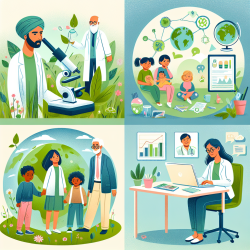Introduction
In today's rapidly evolving world, the importance of linking research and policy to ensure children's environmental health cannot be overstated. The U.S. Environmental Protection Agency (EPA) has prioritized this area, highlighting the critical role data plays in shaping effective policies. As practitioners, especially those involved in online therapy services like TinyEYE, understanding and implementing these research findings can significantly enhance our practice and outcomes for children.
The Role of Research in Policy Making
The research article "Linking Research and Policy to Ensure Children's Environmental Health" underscores the necessity of using data to inform policy decisions. The U.S. EPA's efforts, such as addressing pesticide residues in children's food and revising air quality standards, exemplify how research can drive policy changes that protect children's health.
Why Practitioners Should Care
For practitioners, especially those working in educational settings, understanding these policies and the data behind them is crucial. It allows us to:
- Identify Environmental Risks: Recognize potential environmental hazards that may affect children's health and learning capabilities.
- Advocate for Safe Environments: Use data to advocate for safer school environments and influence policy at a local level.
- Enhance Therapy Outcomes: Integrate environmental health considerations into therapy plans, leading to better outcomes for children.
Implementing Research Findings in Practice
Practitioners can take several steps to incorporate these research findings into their practice:
- Stay Informed: Regularly review current research and policy updates related to children's environmental health.
- Collaborate: Work with other professionals and policymakers to create comprehensive strategies for addressing environmental health issues.
- Educate: Inform parents, teachers, and the community about the importance of environmental health and how it impacts children's development.
Encouraging Further Research
The dynamic nature of environmental health research presents an opportunity for practitioners to contribute to this field. By engaging in research or supporting studies, practitioners can help generate the data needed to drive future policy changes. This proactive approach not only benefits individual practices but also contributes to the broader goal of ensuring healthier environments for all children.
Conclusion
Incorporating research findings into practice is not just beneficial but essential for practitioners dedicated to improving children's health outcomes. By staying informed and actively participating in the research-policy nexus, we can make significant strides in safeguarding the health of future generations.
To read the original research paper, please follow this link: Linking research and policy to ensure children's environmental health.










